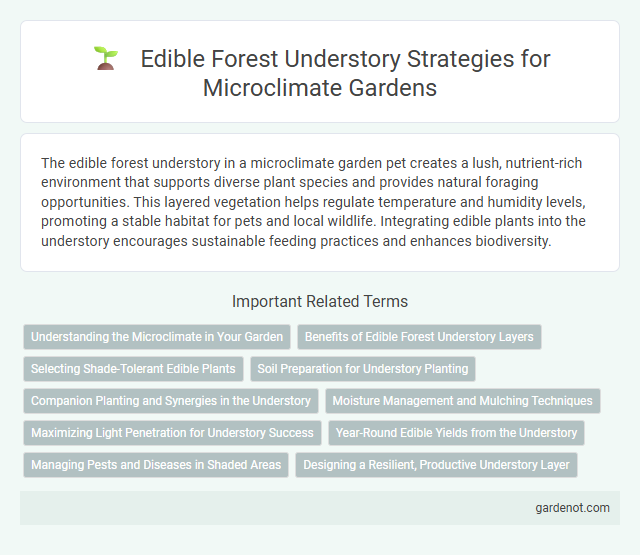The edible forest understory in a microclimate garden pet creates a lush, nutrient-rich environment that supports diverse plant species and provides natural foraging opportunities. This layered vegetation helps regulate temperature and humidity levels, promoting a stable habitat for pets and local wildlife. Integrating edible plants into the understory encourages sustainable feeding practices and enhances biodiversity.
Understanding the Microclimate in Your Garden
The edible forest understory thrives within a carefully balanced microclimate, where temperature, humidity, and light levels create an optimal environment for shade-tolerant, nutrient-rich plants such as ramps, wild leeks, and shade-loving berries. Recognizing the specific microclimate variations beneath the canopy helps gardeners select understory species that improve soil health, conserve moisture, and enhance biodiversity. Monitoring factors like wind shelter, soil temperature, and moisture retention directly influences the vitality and productivity of edible forest garden layers.
Benefits of Edible Forest Understory Layers
Edible forest understory layers enhance biodiversity by providing habitat for pollinators and beneficial insects, which improves overall ecosystem health. These layers contribute to soil fertility through natural nutrient cycling and promote water retention, reducing erosion and supporting sustainable microclimates. Growing shade-tolerant, nutrient-rich plants like berries, herbs, and mushrooms offers diverse food sources while maximizing space efficiency in microclimate garden systems.
Selecting Shade-Tolerant Edible Plants
Selecting shade-tolerant edible plants for the microclimate garden's edible forest understory ensures successful growth beneath taller canopy layers. Ideal species include woodland favorites like ramps (Allium tricoccum), wild ginger (Asarum canadense), and shade-adapted herbs such as mint (Mentha spp.) and lemon balm (Melissa officinalis). Prioritizing plants with high shade tolerance and nutritional value maximizes yield and biodiversity in shaded microclimate zones.
Soil Preparation for Understory Planting
Soil preparation for edible forest understory planting requires deep loosening and enrichment with organic matter to support diverse root systems. Incorporating compost, leaf mold, and mulch enhances microbial activity and moisture retention critical for understory species like shade-tolerant herbs and berries. Ensuring well-drained, nutrient-rich soil fosters robust growth and sustainable yields within the microclimate garden ecosystem.
Companion Planting and Synergies in the Understory
Edible forest understory thrives through strategic companion planting, where species such as herbs, berries, and shade-tolerant vegetables create mutual benefits by enhancing soil fertility, repelling pests, and attracting pollinators. Synergies in the understory improve microclimate regulation by maintaining humidity and reducing temperature fluctuations, which fosters plant resilience and productivity. Integrating nitrogen-fixing plants like clover or comfrey boosts nutrient cycling, supporting the growth of fruiting shrubs and perennial vegetables in the lower layers of the garden.
Moisture Management and Mulching Techniques
Effective moisture management in edible forest understory gardens relies on strategic mulching techniques that retain soil moisture and regulate temperature. Organic mulches such as shredded leaves, straw, and wood chips create a protective layer that reduces evaporation and suppresses weed growth, enhancing soil health and moisture availability. Incorporating thick mulch layers mimics natural forest floor conditions, promoting microclimate stability and supporting diverse understory plant growth.
Maximizing Light Penetration for Understory Success
Maximizing light penetration in an edible forest garden understory involves strategic pruning and selecting shade-tolerant crops like leafy greens and herbs that thrive in dappled sunlight. Utilizing species with varying canopy structures enhances light distribution, promoting photosynthesis and growth beneath taller trees. Implementing reflective mulches and maintaining optimal spacing between plants further boosts light availability for understory productivity.
Year-Round Edible Yields from the Understory
The edible forest understory provides a diverse array of nutrient-rich crops such as berries, herbs, and perennial vegetables that thrive beneath the canopy, ensuring continuous harvests throughout the year. Species like shade-tolerant blueberries, wild garlic, and ground cherries adapt to microclimate variations, optimizing food production in limited sunlight and cooler temperatures. Integrating these plants into a microclimate garden enhances biodiversity, soil health, and resilience while maximizing space for sustainable, year-round edible yields.
Managing Pests and Diseases in Shaded Areas
Managing pests and diseases in the shaded understory of an edible forest garden requires selecting shade-tolerant, pest-resistant plant species such as wild ginger and medicinal herbs. Implementing integrated pest management (IPM) techniques, including biological controls like predatory insects and fungal antagonists, helps maintain ecological balance without chemical intervention. Maintaining proper airflow and soil health through mulching and pruning reduces humidity-related fungal infections common in shaded microclimates.
Designing a Resilient, Productive Understory Layer
Designing a resilient, productive edible forest understory involves selecting shade-tolerant perennial crops such as ramps, ostrich ferns, and wild leeks that thrive beneath tree canopies. Integrating nitrogen-fixing plants like Siberian pea shrub enhances soil fertility while diverse layers improve microclimate stability and pest resistance. Incorporating mulching and perennial groundcovers maximizes moisture retention, supports beneficial microbes, and establishes a sustainable, food-producing ecosystem.
Edible forest understory Infographic

 gardenot.com
gardenot.com